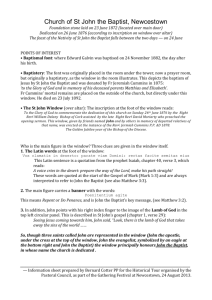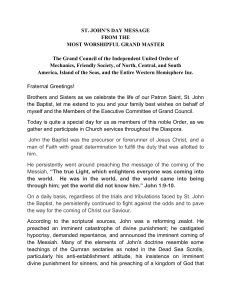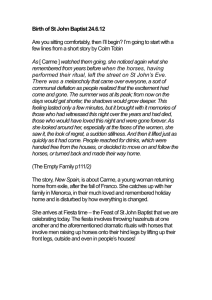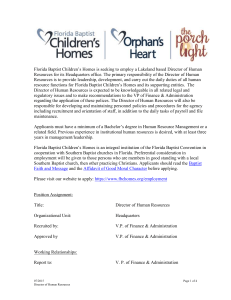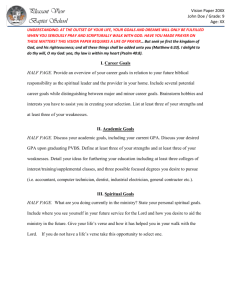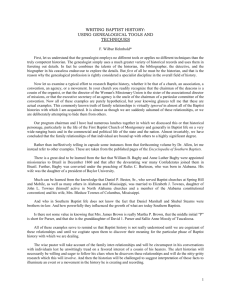Park Baptist Church, An Arch
advertisement
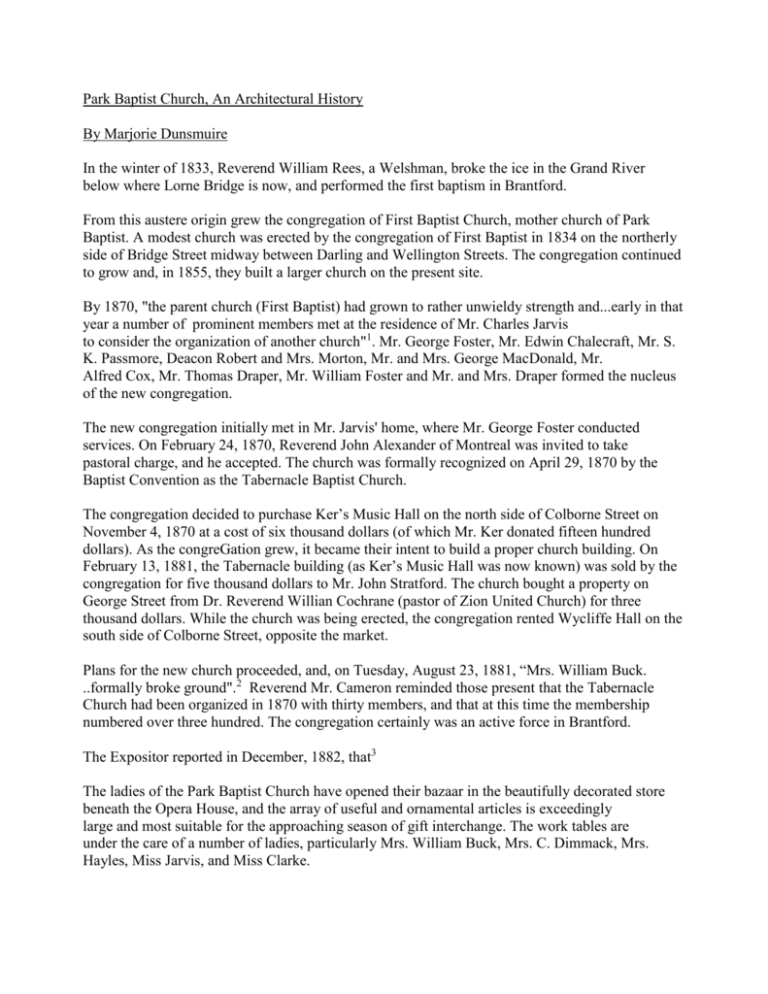
Park Baptist Church, An Architectural History By Marjorie Dunsmuire In the winter of 1833, Reverend William Rees, a Welshman, broke the ice in the Grand River below where Lorne Bridge is now, and performed the first baptism in Brantford. From this austere origin grew the congregation of First Baptist Church, mother church of Park Baptist. A modest church was erected by the congregation of First Baptist in 1834 on the northerly side of Bridge Street midway between Darling and Wellington Streets. The congregation continued to grow and, in 1855, they built a larger church on the present site. By 1870, "the parent church (First Baptist) had grown to rather unwieldy strength and...early in that year a number of prominent members met at the residence of Mr. Charles Jarvis to consider the organization of another church"1. Mr. George Foster, Mr. Edwin Chalecraft, Mr. S. K. Passmore, Deacon Robert and Mrs. Morton, Mr. and Mrs. George MacDonald, Mr. Alfred Cox, Mr. Thomas Draper, Mr. William Foster and Mr. and Mrs. Draper formed the nucleus of the new congregation. The new congregation initially met in Mr. Jarvis' home, where Mr. George Foster conducted services. On February 24, 1870, Reverend John Alexander of Montreal was invited to take pastoral charge, and he accepted. The church was formally recognized on April 29, 1870 by the Baptist Convention as the Tabernacle Baptist Church. The congregation decided to purchase Ker’s Music Hall on the north side of Colborne Street on November 4, 1870 at a cost of six thousand dollars (of which Mr. Ker donated fifteen hundred dollars). As the congreGation grew, it became their intent to build a proper church building. On February 13, 1881, the Tabernacle building (as Ker’s Music Hall was now known) was sold by the congregation for five thousand dollars to Mr. John Stratford. The church bought a property on George Street from Dr. Reverend Willian Cochrane (pastor of Zion United Church) for three thousand dollars. While the church was being erected, the congregation rented Wycliffe Hall on the south side of Colborne Street, opposite the market. Plans for the new church proceeded, and, on Tuesday, August 23, 1881, “Mrs. William Buck. ..formally broke ground".2 Reverend Mr. Cameron reminded those present that the Tabernacle Church had been organized in 1870 with thirty members, and that at this time the membership numbered over three hundred. The congregation certainly was an active force in Brantford. The Expositor reported in December, 1882, that3 The ladies of the Park Baptist Church have opened their bazaar in the beautifully decorated store beneath the Opera House, and the array of useful and ornamental articles is exceedingly large and most suitable for the approaching season of gift interchange. The work tables are under the care of a number of ladies, particularly Mrs. William Buck, Mrs. C. Dimmack, Mrs. Hayles, Miss Jarvis, and Miss Clarke. Work on the new church building progressed steadily. On June 8;, 1883, the Expositor revealed that ...the beautiful edifice is complete in its comfort and elegance, and is one of the handsomest and most complete churches in the city. Much praise is due to the Building Committee, Messrs. Wm. Buck, chairman; Geo. Foster, S.G. Read, Alfred Cox, Chas. Jarvis, and Reverend Mr. Cameron, who have been ever diligent, carefully noting the unfolding place of worship, as it gradually arose from the piles of debris and now stands a noble pile, beautiful within and without. “While in course of construction the Expositor christened it --from its location – the “ParK” Baptist Church, which name was, later, adopted by the church. On June 3, 1883, the Park Baptist Church was officially opened and dedicated. Hundreds of people gathered for the morning and evening services to admire the church. The church was constructed of red brick and stone, the exterior being tuckpointed red. Four entrances graced the church, two through the towers at the front of the church, and two in the rear extension. The front towers were surmounted by iron cresting and terminals made by William Buck. On each side of the tower entrances were red granite columns with carved pedestals and bases. The rear part of the building (three stories) was designed for Sunday School purposes. The upper floor of this rear part had a large room 50 X 28 with two side rooms separated from it by folding glass doors. The ceiling was 28 feet in height and had a hammer-beam roof composed entirely of wood. The ground floor had a ladies parlour (40 X 28), a classroom (20 X 22) and a vestry. The basement had a large room (50 X 28), two side rooms (18 X 16), and a f'urnace room which had three hot air furnaces. The roof was neatly slated by Messrs. Brown. The iron cresting of the roof corresponded with that on the towers. The plastering was done by Messrs. Wood and Jennings. Mr. John Tainsh did the brush painting; Mr. Lac Mayo did the painting by stencil. The stone facings and ornaments were the work of M. Bates. The whole contract was given to Mr. Thomas Large. The plans, specification and details were prepared by Mr. John Turncr "under whose careful supervision the whole has been carried out, and (it) is a credit to his genius”. 5 Total cost of the building was approximately $21,000. 6 In the sanctuary of the church, the seating was semi-circular, and had an inclination from front to rear of about two feet. It was carpeted with a “tapestry carpet of neat design and quiet colours, the pulpit platform being richly carpeted with Brussels carpet".7 The pews were made of black (walnut?) and finished in oil on the natural wood. They were cushioned with crimson rep cushions, done by Mr. Wm. Pierce. The choir platform was in the rear of the pulpit platform and above the baptistry, built with waiting rooms on either side. Encircling the auditorium was a gallery capable of seating threr hundrcd. The front of this was an iron balcony, especially designed by the architect. The ceiling was an octagonal shape wlith plaster mouldings, and heavy cornices at the sides, beneath which there was a very neat stencil border, in tints. The windows were stained in beautiful designs, and were furnished by Messrs. Lyons & Co. , Toronto, through Mr. John Tainsh. The chandelier in the centre of the ceiling was purchased in New York. In the towers two hanging lamps were suspended. These fixtures were all finished in nickel. The Expositor praised the new church highly in their description8 The new and handsome edifice erected upon the southwest corner of Darling and George Streets , facing Victoria Square, is now competed, and adds another beauty to our city, and is another monument to the push and energy of the pcople of the "City of Churches". Park Baptist has, of course, undergone various alterations since it was built. In 1901 two furnaces for coal, replacing those of wood, were installed. In that year, as well, an outside entrance to the basement was opened. A major renovation took place in 1910, the total cost of which was over $20,000.9 On the outside, a portico of red brick, with stained glass windows and oak-grained doors, was added, forming an entrance to the church. Windows were added to the Sunday School and the stonework in the front pillars was retouched. The changes to the interior were also extensive. In the sanctuary, the organ console was removed to the front of the sanctuary. The pews were stained oak and the pillars supporting the Gallery were palnted to represent marble. The seating capacity was enlarged so that the sanctuary was able to seat approximately six hundred. In the gallery, tho old entrances were removed, and alterations increased thc seating capacity by two hundred and forty. An auditorium was added to the basement, for use as a Sunday School. This room had a capacity for three hundred and fifty, and could be divided into classrooms by means of sliding burlap-covercd doors. To the rear of this schoolroom were the furnace and storage rooms, a lavatory, and a kitchen. The church was also improved by the installation of a new heating system (steam radiators) and a lighting system (gas and electric fixtures). In the years 1926-1931, there was “renovation of the church together with the building of the parsonage on a lot purchased from Central Presbyterian Church".10 A new organ was also installed installed (the old one being sold for $1,000). In 1947 the church auditorium was redecorated. New cushions for the pews cost $688.00, while the new carpet was a gift of Mrs. Bauslaugh. A new boiler ($6000) was installed in 1958. The kitchen was renovated in 1959 at a cost of $3859.80. In 1961, Park Baptist Church bought the building and lot adjacent to the church for $28,500. The house was demolished in July, 1978, to provide parking space. Extensive renovation took place in 1970 in preparation for the Ontario-Quebec convention. The whole church, including the Sunday School auditorium, halls, stairs, and the sanctuary, were refurbished. The electirc wiring was overhauled, and in the towers, floodlighting and chimes were installed. The roof and eavestroughing were replaced. As well, the heating was changed from coal to gas and the church walls and ceiling were insulated. In Park Baptist Church, “an atmosphere of rest, of devotional spirit, of all that ends to make the worship of God an impressive act, seems to pervade the entire structure."11 Now, in 1978, a structural investigation of the church building is being done to determine its present condition. Park Baptist Church is a picturesque link to Brantford's past; if possible, it must be preserved for future generations to enjoy. Notes: 1. E.G. Fox, "History of Park Baptist Church 1870-1970" (Brantford ; 1970), p. 2. 2. Brantford Expositor, "The New Baptist Church" August 26,1881 (weekly). 3. Brantford Expositor, “Baptist Bazaar" December 22, 1882 (weekly). 4. Brantford Expositor, "Dedicated - The Park Baptist Church Opened for Worship" June 8 , 1883 (weekly). 5. Brantford Expositor, "Park Baptist Church" June 8, 1883 (weekly). 6. Ibid. 7. Ibid. 8. Ibid. 9. Brantford Expositor, "New Park Baptist Church" Apri1 30, 1910 (daily). 10. E.G. Fox, p. 12 11. Brantford Expositor, "New Park Baptist Church" Apri1 30, 1910 (daily).
